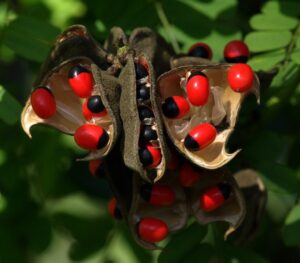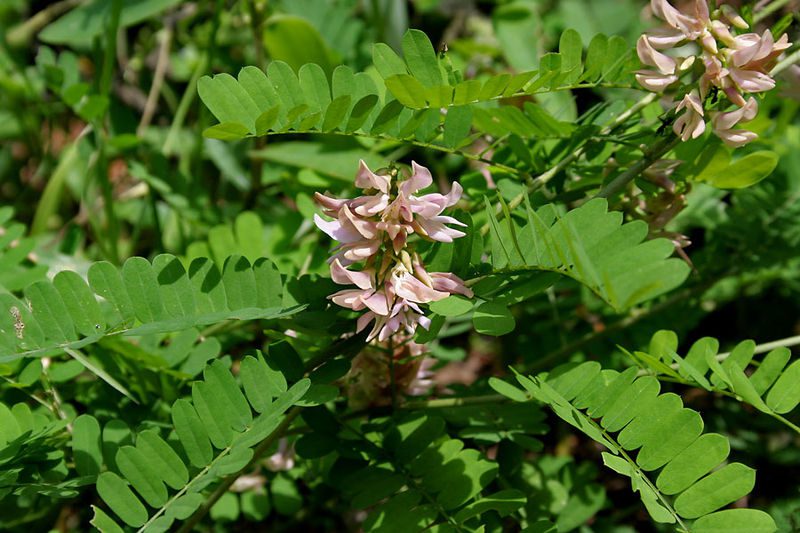Herb
Gunja (Abrus precatorius) Herb Ayurvedic Overview
Gunja (Abrus precatorius) is a woody twinning herb found almost in all tropical countries, ascending to 1200 m with distinctive toxic Rakta seeds through a black mark at the base. Leaves of the gunja plant look like tamarind leaves having 20-40 leaflets. It is much-branched, slender, woody, spiky twinning. The stem is a brown color having wrinkled, and cylindrical with a smooth surface. Commonly, Gunja occurs in two forms, the one with red seed and the other with white seed.
The leaves of gunja (Abrus precatorius) are differentiated by 7-20 pairs of obtuse, oblong, stipulate, and truncate. The flowers are short and are of pinkish-white color. Pods are hairy, oval, turgid, and 3-5 seeds are found with a black mark at the base. The seeds of Shodhit gunja are effectively managing the itching, urinary disorders, alopecia, edema, nervous disorders, pneumonia, skin diseases, dry cough, rheumatism, leucoderma, etc.
It is also known to have laxative (aids bowel movement), aphrodisiac (increase libido), and expectorant (remove excess phlegm) properties. The leaves, roots, and seeds of the gunja plant contain several active compounds that provide medicinal and pharmacological properties. Purified gunja is applied externally to relieve joint pains, sciatica pain, and swelling, cervical spondylosis-related pain.
Table of Contents
Scientific Classification of Gunja (Abrus precatorius):
- Kingdom: Plantae
- Subkingdom: Tracheobionta
- Division: Magnoliophyta
- Superdivision: Spermatophyta
- Class: Magnoliopsida
- Subclass: Rosidae
- Order: Fabales
- Family: Fabaceae
- Subfamily: Faboideae
- Tribe: Abreae
- Genus: Abrus
- Species: Abrus precatorius
Gunja (Abrus precatorius) Synonyms:
- Sanskrit: Raktika, Kakananti
- Assamese: Rati
- Bengali: Kunch, Shonkainch
- English: Jequirity
- Gujrati: Rati, Chanothee
- Hindi: Ratti, Ghungchi
- Kannada: Galuganji, Gulagunjee
- Kashmiri: Kath
- Malayalam: Kunni, Cuvanna Kunni
- Marathi: Gunja
- Oriya: Kainch
- Punjabi: Ratti
- Tamil: Kuntri, Kunrimani, Kundamani
- Telugu: Guriginja, Gurivinda
- Urdu: Ghongcha, Ratti
Gunja (Abrus precatorius) Description:
 a) Macroscopic: Gunja plant is characterized by a smooth, glossy surface and bright scarlet color with black patch hilum. It is ovoid or sub-globular, having 5-8 mm long and 4-5 mm broad.
a) Macroscopic: Gunja plant is characterized by a smooth, glossy surface and bright scarlet color with black patch hilum. It is ovoid or sub-globular, having 5-8 mm long and 4-5 mm broad.
b) Microscopic: The transverse section of the seed shows testa, which is about 75 µ thick. The more significant parts being formed by the epidermis and are composed of radially and many elongated cells. They are arranged irregularly and measure about 45-50 µ in length. The inner region of the thin testa consists of collapsed cells forming a hyaline layer about 25 µ thick. The endodermis is composed of thick-walled cellulosic parenchyma, and isodiametric cells are much larger inside. The walls are mainly hemicellulose and swell considerably in water. The outermost layers of endodermis cells (pseudoepidermis) are formed of relatively more minor cells, walls of which swell to less extent in water.
Identity, Purity, and Strength of Gunja (Abrus precatorius):
- Foreign matter Not more than 2 percent, Appendix 2.2.2.
- Total Ash Not more than 3 percent, Appendix 2.2.3.
- Acid-insoluble ash Not more than 0.5 percent, Appendix 2.2.4.
- Alcohol-soluble extractive Not less than 3 percent, Appendix 2.2.6.
- Water-soluble extractive Not less than 15 percent, Appendix 2.2.7.
Chemical Constituents of Gunja (Abrus precatorius):
The root of Gunja is rich in precol, abrasine, abruslactone, anthocyanins, abrussic-acid, calcium, abrusgenic-acid-methyl-ester, precasine, abrol. The seeds contain a high amount of precatorine, trigonelline, hederagenin, amino acids like serine, hypaphorine, sophoradiol, haemagglutinin, aglucoside abrussic acid, abrin, kaikasaponin III. And leaves are rich in trigonelline, hemipholin, abrine, abruslactone A, hypaphorine, glycyrrhizin, precatorine.
Ayurvedic Properties and Action of Gunja (Abrus precatorius):
- Rasa: Tikta, Kashaya
- Guna: Lagu, Rooksha, Tikshana
- Virya: Ushna
- Vipaka: Katu
- Karma: Keshaya, Kandughana, Garbhanirodhaka, Shukrajanan, Balaprada, Tvachya, Vrushya, Vranahara, Chakshushaya.
Ayurvedic Formulation made by Gunja (Abrus precatorius):
The formulation of Gunja are Nelibhringadi Oil, and Sarivadi Vati.
Therapeutic uses of Gunja (Abrus precatorius):
Gunja is indicated in Urustambha, Kasa, Kandu, Kushtha, Graharoga, Amavata, Vrana, Trushna, Brahma, Shwasa, Indralupta.
Dose of Gunja (Abrus precatorius):
60-180 mg of the drug in seed powder.
1-3 gm in root and leaf powder.
Reference:
Ayurvedic Pharmacopeia of India.
For regular health updates, Please follow our Social Pages


